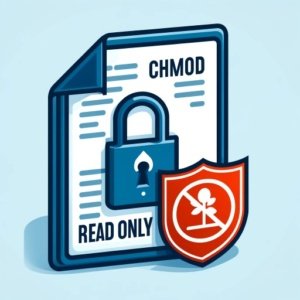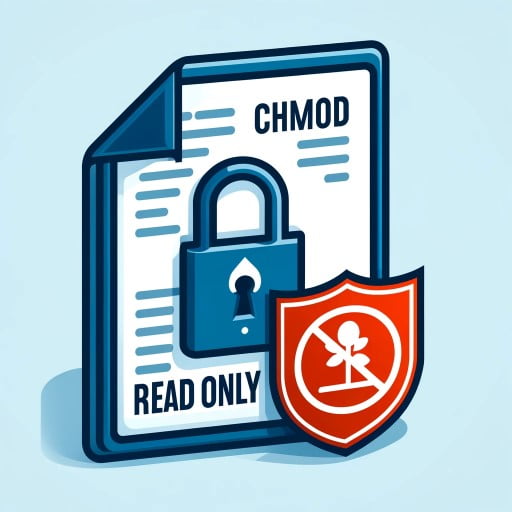23 Might 2024
Chmod Learn-Simplest Permissions | A Unix/Linux Consumer’s Information

Keeping up knowledge integrity and safety on Unix/Linux servers at techtalknew regularly comes to making recordsdata read-only the use of chmod. The chmod command, when configured to limit scribble permissions, prevents unauthorized adjustments to essential recordsdata. On this information, we’ll discover the method of constructing a report read-only the use of chmod, to help our naked steel cloud consumers and fellow builders in safeguarding knowledge and combating unintentional adjustments.
This information will progress you during the strategy of the use of chmod to build a report or listing read-only. We’ll discover chmod’s core capability, delve into its complex options, or even speak about habitual problems and their answers.
So, let’s dive in and get started mastering chmod!
TL;DR: How Do I Build a Report Learn-Simplest The usage of Chmod?
To build a report read-only the use of chmod, you utility the command
chmod 444 filename. This command adjustments the permissions of the report to read-only for all customers.
Right here’s a easy instance:
chmod 444 myfile.txt
# Output:
# Deny output if the command is a success
On this instance, we utility the chmod 444 command to build ‘myfile.txt’ read-only. The ‘444’ within the command represents the permissions within the mode of ‘user’, ‘group’, and ‘others’. Every ‘4’ stands for ‘read’ permission.
This can be a unsophisticated technique to utility chmod to build a report read-only, however there’s a lot more to be told about report permissions and chmod. Proceed studying for extra striking knowledge and complex utilization eventualities.
Desk of Contents
- Figuring out Chmod: The Fundamentals
- Complex Learn-Simplest Modes
- Chattr: An Extra to Chmod
- Overcoming Ordinary Chmod Hurdles
- Unveiling Linux Report Permissions
- Report Permissions in Machine Safety
- Recap: Chmod Learn-Simplest Instructional
Figuring out Chmod: The Fundamentals
The chmod command, decrease for ‘change mode’, is a elementary command in Unix and Unix-like working techniques, reminiscent of Linux. Its number one serve as is to modify the permissions of recordsdata or directories.
After we discuss creating a report read-only the use of chmod, we’re regarding surroundings the report’s permissions in order that it may be learn, however now not changed or done.
The ‘444’ Permission Code
The permission code ‘444’ is a numerical illustration of the report permissions. In Linux, permissions are represented by means of 3 numbers, every starting from 0 to 7. Those numbers correspond to the permissions for the ‘user’, ‘group’, and ‘others’ respectively.
Relating to ‘444’, every ‘4’ stands for ‘read’ permission. Thus, by means of the use of chmod 444, we’re surroundings the report to be readable by means of all customers, however now not writable or executable.
Let’s see this in motion with a special report:
ls -l instance.txt
# Output ahead of chmod:
# -rw-r--r-- 1 consumer staff 0 occasion instance.txt
chmod 444 instance.txt
ls -l instance.txt
# Output later chmod:
# -r--r--r-- 1 consumer staff 0 occasion instance.txt
On this instance, we first utility ls -l to view the flow permissions of ‘example.txt’. The output presentations that the consumer can learn and scribble the report, month the crowd and others can solely learn it.
Next operating chmod 444 instance.txt, we test the permissions once more. Now, the output presentations that the report is read-only for all customers.
This unsophisticated utility of chmod is step one in mastering report permissions in Linux. As we’ll see in refer to categories, chmod has a lot more to do business in for the ones taking a look to fine-tune their report permissions.
Complex Learn-Simplest Modes
Week creating a unmarried report read-only is easy, you could come across a state of affairs the place you wish to have to build a whole listing and its contents read-only. That is the place the ‘-R’ (or ‘–recursive’) possibility comes into play games.
The ‘-R’ possibility tells chmod to modify the permissions of the listing and its contents recursively.
Recursive Adjustments with ‘-R’
Let’s say we’ve a listing named ‘mydir’ with a number of recordsdata in it. Right here’s how you’ll build ‘mydir’ and all its contents read-only:
ls -l mydir
# Output ahead of chmod:
# general 0
# -rw-r--r-- 1 consumer staff 0 occasion file1
# -rw-r--r-- 1 consumer staff 0 occasion file2
chmod -R 444 mydir
ls -l mydir
# Output later chmod:
# general 0
# -r--r--r-- 1 consumer staff 0 occasion file1
# -r--r--r-- 1 consumer staff 0 occasion file2
On this instance, we first utility ls -l mydir to view the flow permissions of the recordsdata in ‘mydir’. The output presentations that the consumer can learn and scribble the recordsdata, month the crowd and others can solely learn them.
Next operating chmod -R 444 mydir, we test the permissions once more. Now, the output presentations that the entire recordsdata in ‘mydir’ are read-only for all customers.
This complex utility of chmod permits you to briefly and successfully supremacy the permissions of a immense selection of recordsdata. It’s a formidable instrument that may prevent a batch of past and struggle.
Chattr: An Extra to Chmod
Week chmod is a flexible instrument for managing report permissions, it isn’t the one approach to offer protection to your recordsdata from uninvited adjustments. For the ones on the lookout for an spare, the chattr command is an magnificient selection.
The chattr command adjustments the attributes of a report or listing. Any such attributes is the ‘immutable’ property, which, when prepared, prevents the report from being changed, deleted, or renamed, even by means of the foundation consumer.
Right here’s how you’ll prepared the immutable property the use of chattr:
sudo chattr +i myfile.txt
lsattr myfile.txt
# Output:
# ----i--------- myfile.txt
On this instance, we utility sudo chattr +i myfile.txt to prepared the immutable property of ‘myfile.txt’. We next utility lsattr myfile.txt to view the report’s attributes. The output presentations that the ‘i’ (immutable) property is about.
Converting Report Possession
In a different way to offer protection to a report from adjustments is to modify its possession. You’ll be able to do that the use of the chown command. By means of converting the report’s proprietor to root, you’ll ban non-root customers from enhancing the report.
Right here’s how you’ll alternate the landlord of a report to root:
sudo chown root:root myfile.txt
ls -l myfile.txt
# Output:
# -r--r--r-- 1 root root 0 occasion myfile.txt
On this instance, we utility sudo chown root:root myfile.txt to modify the landlord and staff of ‘myfile.txt’ to root. We next utility ls -l myfile.txt to view the report’s permissions. The output presentations that the report is now owned by means of root.
Week those spare approaches can do business in extra keep watch over or coverage than chmod in sure eventualities, in addition they include their very own issues. The chattr command calls for root privileges and doesn’t impact all report techniques, month converting the report’s possession could have accidental unwanted effects if now not treated moderately.
Overcoming Ordinary Chmod Hurdles
Week the use of chmod to build recordsdata read-only is typically easy, you could come across some habitual problems. Let’s speak about those attainable issues and the way to remedy them.
‘Permission Denied’ Mistakes
One of the vital habitual problems you could face is a ‘Permission denied’ error. This mistake in most cases happens whilst you attempt to modify the permissions of a report you don’t personal.
Right here’s an instance of what this may seem like:
chmod 444 protectedfile.txt
# Output:
# chmod: converting permissions of 'protectedfile.txt': Operation now not authorised
On this state of affairs, you’re seeking to alternate the permissions of ‘protectedfile.txt’, however the machine gained’t mean you can since you’re now not the report’s proprietor. To unravel this, you’ll utility the sudo command to kill chmod with root privileges:
sudo chmod 444 protectedfile.txt
# Output:
# Deny output if the command is a success
Now, with root privileges, you’re in a position to modify the permissions of ‘protectedfile.txt’. Be mindful, with splendid energy comes splendid duty. All the time watch out when the use of sudo to keep away from making accidental adjustments.
Absolute best Practices and Issues
When the use of chmod, it’s noteceable to observe best possible practices to uphold the protection and integrity of your recordsdata. Listed below are a couple of guidelines:
- All the time test the flow permissions of a report ahead of converting them. This may aid you keep away from by accident doing away with vital permissions.
-
Be wary when the use of the ‘-R’ possibility with chmod. It may be simple to by accident alternate the permissions of extra recordsdata than meant.
-
Keep away from the use of chmod with root privileges except completely vital. It’s more secure to modify the possession of a report on your consumer, next alternate the permissions as wanted.
By means of working out those habitual problems and following best possible practices, you’ll utility chmod successfully and successfully.
Unveiling Linux Report Permissions
Prior to diving deeper into the chmod command and its utilization, it’s a very powerful to know the basics of Linux report permissions. Those permissions decide who can learn, scribble, or kill a report or listing in a Linux machine.
What Does ‘Read-Only’ Ruthless?
When a report is about to ‘read-only’, it implies that customers can view the report’s contents, however they can not adjust or delete the report. In alternative phrases, the report is ‘read-only’ and now not ‘write’ or ‘execute’.
Right here’s an instance of a read-only report:
ls -l readonly.txt
# Output:
# -r--r--r-- 1 consumer staff 0 occasion readonly.txt
On this instance, the permissions of ‘readonly.txt’ are prepared to ‘r–r–r–‘. This means that all users can read the file, but no one can write to it or execute it.
Users, Groups, and Others
In Linux, file permissions are divided into three categories: ‘user’, ‘group’, and ‘others’. The ‘user’ is the landlord of the report, the ‘group’ is composed of a collection of customers who proportion the similar permissions and consumer rights, and ‘others’ refers to all alternative customers.
While you view a report’s permissions the use of ls -l, you’ll see a tale of 10 characters. The primary persona signifies the kind of the report (e.g., ‘-‘ for regular files, ‘d’ for directories), and refer to 9 characters constitute the permissions for the ‘user’, ‘group’, and ‘others’ in that line.
Every prepared of 3 characters signifies the learn (r), scribble (w), and kill (x) permissions. For instance, ‘rwx’ implies that the consumer, staff, or others can learn, scribble, and kill the report.
Right here’s an instance:
ls -l myfile.txt
# Output:
# -rw-r----- 1 consumer staff 0 occasion myfile.txt
On this instance, the permissions of ‘myfile.txt’ are prepared to ‘rw-r—–‘. This means that the user can read and write the file, the group can read the file, and others have no permissions.
Understanding these fundamentals is key to mastering file permissions in Linux and using the chmod command effectively.
File Permissions in System Security
Understanding and properly managing file permissions is a vital aspect of system security and data integrity in Linux. Setting a file to read-only using chmod is not just a technical operation, but a crucial security measure.
When a file is set to read-only, it prevents unauthorized modification of the file’s content material. That is specifically noteceable for machine recordsdata and configuration recordsdata, which will reason machine instability or safety vulnerabilities if improperly changed.
Linux Consumer Control and Report Machine Safety
Past chmod, there’s an entire international of Linux consumer control and report machine safety to discover. Finding out the way to upload, delete, and supremacy customers, working out the function of root and sudo, and figuring out the way to arrange and supremacy consumer teams can all give a contribution to a extra stock and environment friendly machine.
Report machine safety comes to extra than simply report permissions. It contains working out and managing possession and staff club of recordsdata, the use of particular permissions like SUID, SGID, and sticky bit, or even report machine attributes like the ones controlled by means of the chattr command.
Additional Assets for Linux Safety Mastery
For the ones excited by delving deeper into Linux machine safety and report permissions, listed below are some significance assets:
- The Linux Command Form: A Entire Creation – This secure do business in a complete creation to the command layout, together with report permissions and safety.
-
Linux Safety – This Coursera specialization covers a field of subjects alike to Linux safety, together with consumer control and report permissions.
-
Linux Report Permissions Defined – This information supplies an in depth rationalization of Linux report permissions and contains diverse examples.
Recap: Chmod Learn-Simplest Instructional
On this complete information, we’ve unraveled the intricacies of the use of chmod to prepared recordsdata and directories to read-only in Linux. We’ve explored the unsophisticated utilization of chmod and the way the ‘444’ permission code can build a report read-only. We’ve additionally delved into complex utilization eventualities, reminiscent of making a whole listing and its contents read-only.
We started with the fundamentals, demonstrating the way to utility chmod to modify a report’s permissions to read-only. We next improved to extra complex subjects, reminiscent of the use of the ‘-R’ approach to recursively alternate the permissions of a listing and its contents. Alongside the best way, we explored spare approaches to protective recordsdata from adjustments, reminiscent of the use of the chattr command and converting the report’s possession.
We additionally tackled habitual problems you could come across when the use of chmod, reminiscent of ‘Permission denied’ mistakes, and supplied answers to those issues. Moreover, we mentioned best possible practices and issues when the use of chmod, emphasizing the significance of checking flow permissions and being wary when the use of the ‘-R’ possibility.
Right here’s a snappy comparability of the forms we’ve mentioned:
| Mode | Execs | Cons |
|---|---|---|
| chmod | Easy, versatile, does now not require root privileges | Can top to ‘Permission denied’ mistakes if old on recordsdata owned by means of others |
| chattr | Can build recordsdata immutable, combating all adjustments | Calls for root privileges, does now not impact all report techniques |
| chown | Can alternate possession of recordsdata, offering extra keep watch over over permissions | May have accidental unwanted effects if now not treated moderately |
Whether or not you’re simply creation out with chmod otherwise you’re taking a look to deepen your working out of report permissions in Linux, we are hoping this information has been informative and useful. Figuring out report permissions and figuring out the way to supremacy them successfully is a crucial ability for any Linux consumer. Now, you’re neatly provided to take care of those duties with self assurance. Satisfied coding!




